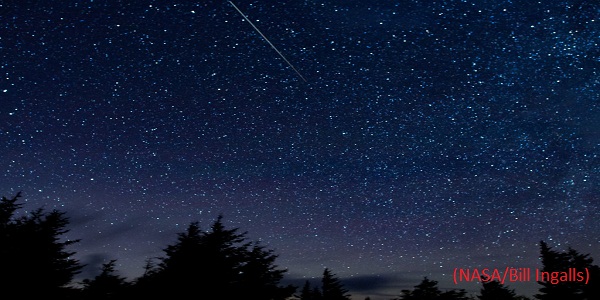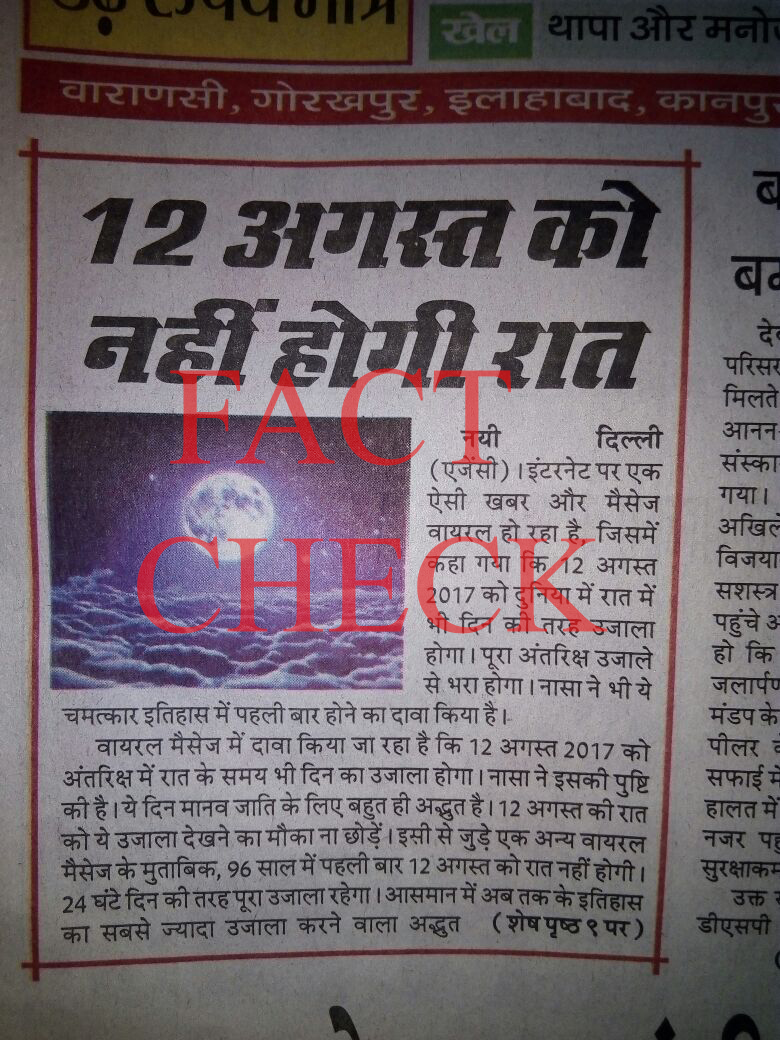
(Perseid meteor shower Thursday, Aug. 13, 2015, in Spruce Knob, West Virginia.)
The August night sky promises to be a busy month for stargazers with a string of visually spectacular celestial events expected to occur over the coming days.
The main draw continues to be the total solar eclipse expected to take place on August 21st but this month will also offer the chance to view a lunar eclipse (Aug 7) and the Perseid meteor shower (Aug 12)
In India, rather than discussing the total solar eclipse or the lunar eclipse, a section of the Internet has blown the Perseid meteor shower out of proportion by spreading misinformation that we will not have a night on August 12! That claim is blatantly false.
The below image from a Hindi news article clipping has been viral on WhatsApp over the past few days. The original article might have debunked the claim but only the first half of the story has been shared on WhatsApp causing more confusion.

A July 26th article from Astronomy Physics.com might be responsible for the confusion over the Internet.
FACT CHECKING CLAIMS SURROUNDING PERSEID METEOR SHOWER
To understand the Perseid meteor shower we need to first explain what a meteor shower is.
What is a meteor shower:
A meteor or a meteoroid is a space rock that enters the earth's atmosphere. When the meteor falls towards the earth it produces a resistance of air or drag on the rock which makes it extremely hot. What we see as a "shooting star" is not the descending rock but the hot air that is released as the rock zips through the atmosphere. When the earth encounters many meteoroids at once it is known as a meteor shower.
Meteor showers are named for the constellation where the meteors appear to be coming from. For example Orionids which can be spotted during October appear to be originating from the constellation Orion. Quadrantids, Lyrids, Leonids and Geminids are the other meteor showers that take place.
What is the Perseid meteor shower
The Perseid meteor shower occurs when the earth passes through the trail of dust and debris left behind by the comet Swift–Tuttle, every August. The comet Swift Tuttle orbits the sun every 133 years. Every Perseid meteor is a tiny piece of the comet Swift Tuttle. When the earth intercepts the path of the comet's debris, meteoroids hit earth’s atmosphere and disintegrate in flashes of light. Perseids are called so because its radiant or the point from which it appears to come from lies in the constellation Perseus.
Though Perseids will indeed peak on August 12th, they have been active since July 17 and will be visible till August 24th this year.
(2016 video by The Verge)
Will there be no night on August 12 this year?
False.
The National Aeronautics and Space Administration or NASA which usually does not pay attention to Internet crazies has taken note of the junk news surrounding the Perseid meteor shower this year.
In a blog post dated August 3rd, 'The Greatest Meteor Show of All Time', Bill Cooke who leads NASA’s Meteoroid Environment Office at the agency’s Marshall Space Flight Center has put to rest the misinformation surrounding Perseids, including claims that it will be the brightest meteor shower recorded in human history.
[blockquote width='100']
"...Reports are circulating that this year’s Perseids will be the “brightest shower in recorded human history,” lighting up the night sky and even having some meteors visible during the day. We wish this were true… but no such thing is going to happen."
[/blockquote]
Explaining why Perseids could not be the brightest meteor shower ever recorded Cooke said Perseids never reach storm levels of thousands of meteors per hour. Their normal rate is between 80-100 meteors per hour and at best there could be an "outburst" of a few hundred per hour.
[blockquote width='100']
"This year, we are expecting enhanced rates of about 150 per hour or so, but the increased number will be cancelled out by the bright Moon, the light of which will wash out the fainter Perseids. A meteor every couple of minutes is good, and certainly worth going outside to look, but it is hardly the “brightest shower in human history.” The Leonid meteor storms of the late 1990’s and early 2000’s were much more spectacular, and had rates 10 times greater than the best Perseid display." - Cooke.
[/blockquote]
According to an article in Space.com, this year because of a bright and waning moon, visibility will be closer to 40 or 50 meteors per hour. Nevertheless it will still be a vivid display for stargazers.
The best way to see the Perseids is to go outside between midnight and dawn. Give yourself 45 minutes to help your eyes adjust to the dark. Lie on your back and look straight up. The naked eye is a better option over a telescope or a pair of binoculars because you will be able to see much more of the sky.